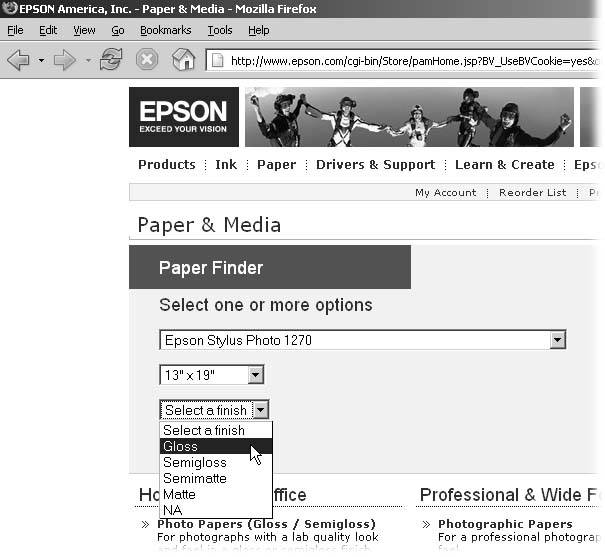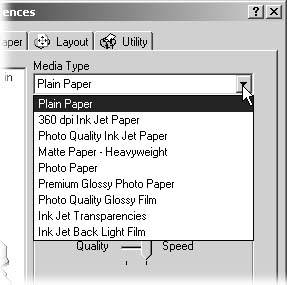4.3. Choosing Printer Paper Laser printers aren't very picky about their paper. Buy plain old copy machine paper, available at office supply and drug stores worldwide, and your printouts will look just fine. (If you're one of the lucky few who own a color laser printer, buy paper specifically designed for color laser printers; the regular stuff won't hold the color well, and inkjet paper won't work.) Inkjet printers, on the other hand, are very picky about paper. They can't use laser printer paper, as it lacks a polymer coating a special chemical that lets the ink bind with the paper. Without the polymer, the ink smears, leading to blurring, dirty nozzles, and ink smears. Although they're picky, inkjet printers still give you plenty of different paper types to choose from. In fact, manufacturers have flooded the market with different paper varieties. To help confused customers choose the right inkjet paper for their printer, Epson even offers the fairly useful Epson Paper Finder, which you can visit at www.epson.com (see Figure 4-6). Figure 4-6. Epson sells inkjet paper in hundreds of sizes and styles to please professionals as well as consumers. To find the right paper for your printer, select your printer model, desired paper size , and the paper's finish. Epson quickly whittles its whopping list down to a handful of suitable choices. 
When choosing paper for your inkjet printer, narrow down the pack by following these steps. -
Choose paper that fits in your printer's tray . Paper comes in a wide variety of sizes, so measuring the size of your printer's paper tray rules out many contenders. Most inexpensive printers can't handle paper wider than the standard eight and a half inches, although they still work with longer, legal sized (8.5 x 14 inch) paper. If the paper tray has a "slider" for adjusting its width, measure the tray with the slider at full width. Many printers choke on thick "heavy weight" papers, often used to print cards or special photos. To find out your printer's paper-size and weight limitations, visit its manufacturer's Web site. Head for the Customer Service area, and look up your printer model to see any limitations on paper size and weight.
Tip: Does your printer specifically call itself a "photo printer"? If not, rule out photo paper. Photo printers contain special cartridges with extra colors to print realistic photographs; regular printers don't contain enough colors to produce quality photos.
-
Choose the paper listed on your printer's Preferences menu . Your printer needs to know what type of paper you inserted in order to spray the right amount of ink. To see what paper your printer understands, visit the printer's Preferences menu. Choose Start  Control Panel Control Panel  Printers and Faxes. Right-click your printer, and choose Printing Preferences to see its favorite papers, as shown in Figure 4-7. Most office supply stores carry those particular paper typeseither as created by your printers manufacturer or available in a generic brand. Printers and Faxes. Right-click your printer, and choose Printing Preferences to see its favorite papers, as shown in Figure 4-7. Most office supply stores carry those particular paper typeseither as created by your printers manufacturer or available in a generic brand. Figure 4-7. Printers need to know the type of paper you inserted so they can choose the right mixture of inks to match the paper. Before clicking the Print button, look in your printer's Media Type or Paper Type pull-down menu and select the type of paper you placed in the feeder tray.  -
Choose the paper that matches what you're printing . Don't be surprised to see stores listing a paper's "weight" on the package; to find standard copy machine paper, look for "20 pound" weight paper. A "24 pound " weight works better for formal letters , as it's slightly heavier. (The heavier the weight, the thicker the paper.) Most office supply stores carry these types of paper for a variety of jobs. -
Drafts . Quality doesn't matter when printing the evening's spaghetti sauce recipe or tomorrow's shopping list. Although generic "plain" inkjet paper works fine for these sorts of tasks , remember to save your botched printouts, too; the reverse side works fine for printing drafts, maps, and test runs to make sure you correctly set the margins and alignment. -
Office . For printouts you show to others, look for paper designated specifically as "inkjet paper." If it doesn't say inkjet, it lacks the coating that prevents blurring. -
Photos . When printing photos, nothing beats glossy photo paper (Section 4.8); plain paper looks lousy and won't last long. -
Matte . Thicker than standard paper, matte paper uses texture to keep the shine down, making it both durable and non-glare. Some people like the textured look for photographs, since this type of paper doesn't reflect the sun as much as other paper types. -
Specialty . Some inkjet paper isn't really paper at all. Specialty paper (Section 4.6) lets you print on iron-on transfers, labels, transparencies , and other plastic-based fibers.
Tip: Many digital cameras can shoot in "panoramic" mode, great for squeezing in an entire horizon during sunsets. To print these kinds of pictures out, order the longest photo paper that fits in your paper tray. Even if the paper's too wide, you can cut it to the correct width and save the leftovers for printing smaller photos.
|

 Control Panel
Control Panel 